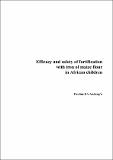Safety of NaFeEDTA as an iron fortificant: effects of fortification using NaFeEDTA on status of zinc and other nutritionally important mineral elements in Kenyan school children
Publication Date
2007Author
Pauline EA Andang’o, Hans Verhoef, Frans J Kok, David L Mwaniki, Rosemary Ayah, Clive E West, Saskia JM Osendarp
Metadata
Show full item recordAbstract/
Food fortification is an effective strategy for reaching populations with micronutrient
deficiencies. Fortification with iron presents a major challenge because of the presence of
phytates and other iron absorption inhibitors in diets of poor people. Addition of iron does not
necessarily mean that it is absorbed. Because of its low cost and its relative stability in food
vehicles, electrolytic iron has been the fortificant of choice in many national programmes,
despite its low bioavailability compared to fortificants such as ferrous salts. NaFeEDTA may
be a more effective iron fortificant in high-phytate foods. Concerns about its cost and safety,
however, have delayed its application in fortification programmes.
This thesis is based on a 5-month randomised placebo-controlled trial conducted among
school children (n = 516) aged 3-8 years in Kenya in May-November 2005. It aimed to
measure the benefits of fortification with NaFeEDTA or electrolytic iron, and to assess the
safety of using NaFeEDTA as an iron fortificant. The specific objectives were to assess a) the
efficacy of fortifying whole maize flour with NaFeEDTA (28 mg iron/kg flour or 56 mg/kg)
or electrolytic iron (56 mg/kg); b) the effect of the intervention on cognitive and motor
function; c) response to the intervention of individuals with α+
-thalassaemia genotype relative
to their counterparts with a normal genotype; d) and the effect of NaFeEDTA on the status of
zinc, calcium, copper, magnesium and manganese.
Fortification with NaFeEDTA at high levels (56 mg iron per kg flour), or low levels (28
mg/kg) reduced the prevalence of iron deficiency anaemia by 89% (95% CI 49% to 97%) and
48% (-20% to 77%), respectively. High-dose fortification with NaFeEDTA led to larger gains
in iron status than low-dose level, and was more efficacious in children with iron deficiency at
baseline. By contrast, electrolytic iron did not improve iron status. There was no evidence that
the iron intervention improved either cognitive or motor function of these children; or that
children with the α+
-thalassaemia genotype responded differently to the iron intervention than
their peers with a normal genotype. There was also no evidence that NaFeEDTA adversely
affected the status of the nutritionally important mineral elements assessed.
The thesis concludes that in high-phytate flours, NaFeEDTA is more suitable than electrolytic
iron for supplementation of iron in the diet. Governments should act and implement national
programmes to fortify industrially processed flour, whereby NaFeEDTA should be considered
the preferred fortificant in high-phytate food vehicles.

